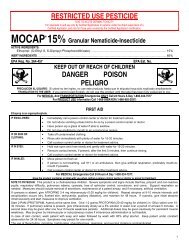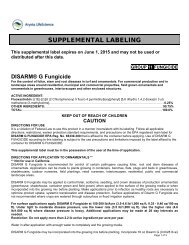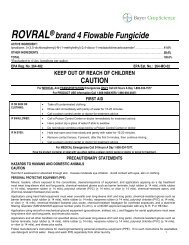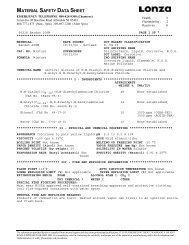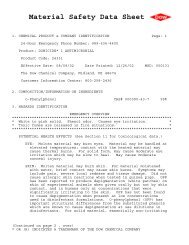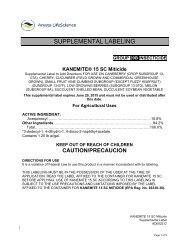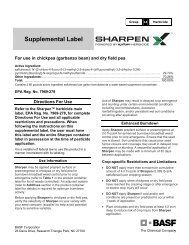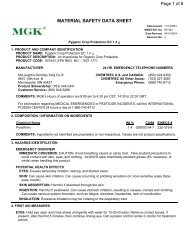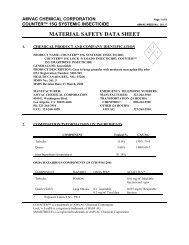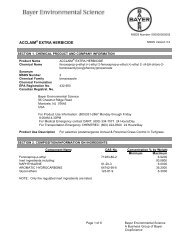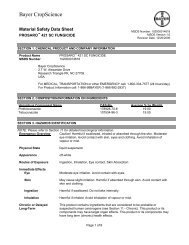Option® Corn Herbicide - Crop Data Management Systems, Inc.
Option® Corn Herbicide - Crop Data Management Systems, Inc.
Option® Corn Herbicide - Crop Data Management Systems, Inc.
Create successful ePaper yourself
Turn your PDF publications into a flip-book with our unique Google optimized e-Paper software.
<strong>Option®</strong> <strong>Corn</strong> <strong>Herbicide</strong><br />
A <strong>Herbicide</strong> for the Control of Annual and Perennial Grass and Broadleaf Weeds in Field <strong>Corn</strong>,<br />
Sweet <strong>Corn</strong> and Popcorn.<br />
ACTIVE INGREDIENTS: Foramsulfuron (CAS Number 173159-57-4) ........................................................................................ 35.0%<br />
INERT INGREDIENTS: ................................................................................................................................................................ 65.0%<br />
This product is a water dispersible granule containing 35% of total active ingredients by weight. TOTAL: 100.0%<br />
EPA Reg No. 264-685<br />
E.P.A. Est. No.<br />
KEEP OUT OF REACH OF CHILDREN<br />
CAUTION<br />
Si usted no entiende la etiqueta, busque a alguien para que se la explique a usted en detalle.<br />
(If you do not understand the label, find someone to explain it to you in detail.)<br />
For MEDICAL And TRANSPORTATION Emergencies ONLY Call 24 Hours A Day 1-800-334-7577<br />
For PRODUCT USE Information Call 1-866-99BAYER (1-866-992-2937)<br />
FIRST AID<br />
IF SWALLOWED: • Call a poison control center or doctor immediately for treatment advice.<br />
• Have person sip a glass of water if able to swallow.<br />
• Do not induce vomiting unless told to do so by a poison control center or doctor.<br />
• Do not give anything by mouth to an unconscious person.<br />
IF IN EYES: • Hold eye open and rinse slowly and gently with water for 15-20 minutes.<br />
• Remove contact lenses, if present, after the first 5 minutes, then continue rinsing eye.<br />
• Call a poison control center or doctor for treatment advice.<br />
IF ON SKIN OR<br />
CLOTHING<br />
• Take off contaminated clothing.<br />
• Rinse skin immediately with plenty of water for 15 – 20 minutes.<br />
• Call a poison control center or doctor for treatment advice.<br />
For MEDICAL Emergencies Call 24 Hours A Day 1-800-334-7577.<br />
Have the product container or label with you when calling a poison control center or doctor or going for treatment.<br />
PRECAUTIONARY STATEMENTS<br />
CAUTION<br />
HAZARD TO HUMANS AND DOMESTIC ANIMALS<br />
Harmful if swallowed. Causes moderate eye irritation. Avoid contact with eyes, skin or clothing. Prolonged or frequently repeated skin<br />
contact may cause allergic reaction in some individuals.<br />
PERSONAL PROTECTIVE EQUIPMENT (PPE)<br />
Some materials that are chemical-resistant to this product are listed below. If you want more options, follow the instructions for category<br />
A on an EPA chemical resistance category selection chart.<br />
Applicators and other handlers must wear: Long-sleeved shirt and long pants, socks, shoes and chemical-resistant gloves made of<br />
any waterproof material such as polyethylene or polyvinyl chloride. Follow manufacturer's instructions for cleaning/maintaining PPE. If<br />
no such instructions for washables, use detergent and hot water. Keep and wash PPE separately from other laundry.<br />
1
Engineering control statement:<br />
When handlers use closed systems, enclosed cabs, or aircraft in a manner that meets the requirements listed in the Worker Protection<br />
Standard (WPS) for agricultural pesticides [(40 CFR §170.240(d)(4-6)], the handler PPE requirements may be reduced or modified as<br />
specified in the WPS.<br />
USER SAFETY RECOMMENDATIONS<br />
Users should wash hands before eating, drinking, chewing gum, using tobacco or using the toilet.<br />
ENVIRONMENTAL HAZARDS<br />
This product is toxic to non-target plants. Do not apply directly to water, to areas where surface water is present or to intertidal areas<br />
below the mean high water mark. Do not contaminate water when cleaning equipment or disposing of equipment washwaters or<br />
rinseate.<br />
This product has a high potential for runoff after application. Poorly draining soils and soils with shallow water tables are more prone to<br />
produce runoff that contains this product. A level, well-maintained vegetative buffer strip between areas to which this product is applied<br />
and surface water features such as ponds, streams and springs will reduce the potential for contamination of water from runoff. Runoff<br />
of this product will be reduced by avoiding applications when rainfall is forecasted to occur within 48 hours. Sound erosion control<br />
practices will reduce this product’s contribution to surface water contamination.<br />
DIRECTIONS FOR USE<br />
It is a violation of Federal law to use this product in a manner inconsistent with its labeling.<br />
Read entire label before using this product.<br />
Do not apply this product in a way that will contact workers or other persons, either directly or through drift. Only protected handlers may<br />
be in the same area during application. For any requirements specific to your State or Tribe, consult the agency responsible for<br />
pesticides.<br />
AGRICULTURAL USE REQUIREMENTS<br />
Use this product only in accordance with its labeling and with the Worker Protection Standard, 40 CFR part 170. This standard contains<br />
requirements for the protection of agricultural workers on farms, forests, nurseries, and greenhouses, and handlers of agricultural<br />
pesticides. It contains requirements for training, decontamination, notification and emergency assistance. It also contains specific<br />
instructions and exceptions pertaining to the statements on this label about personal protective equipment (PPE) and restricted entry<br />
intervals. The requirements in this box only apply to uses of this product that are covered by the Worker Protection Standard.<br />
Do not enter or allow worker entry into treated areas during the restricted entry interval (REI) of 12 hours.<br />
PPE required for early entry to treated areas that is permitted under the Worker Protection Standard and that involves contact with<br />
anything that has been treated such as plants, soil or water, is coveralls over long-sleeved shirt and long pants, socks and shoes and<br />
chemical-resistant gloves made of any waterproof material such as polyethylene or polyvinyl chloride.<br />
Do not contaminate water, food or feed by storage or disposal.<br />
PESTICIDE STORAGE<br />
STORAGE AND DISPOSAL<br />
Keep container tightly closed when not in use. Avoid cross contamination with other pesticides.<br />
PESTICIDE DISPOSAL<br />
Wastes resulting from the use of this product may be disposed of on site or at an approved waste disposal facility.<br />
CONTAINER DISPOSAL<br />
Non-refillable container. Do not reuse or refill this container. Offer for recycling, if available. Triple rinse container (or equivalent)<br />
promptly after emptying. Triple rinse as follows: Empty the remaining contents into application equipment or a mix tank. Fill the<br />
container ¼ full with water and recap. Shake for 10 seconds. Pour rinsate into application equipment or a mix tank or store rinsate for<br />
later use or disposal. Drain for 10 seconds after the flow begins to drip. Repeat this procedure two more times. Then puncture and<br />
dispose of in a sanitary landfill, or by incineration; or, if allowed by State and local authorities, by burning. If burned, stay out of smoke.<br />
2
GENERAL INFORMATION<br />
<strong>Option®</strong> <strong>Corn</strong> <strong>Herbicide</strong> is a sulfonylurea herbicide. <strong>Option®</strong> <strong>Corn</strong> <strong>Herbicide</strong> is intended for application as a foliar spray in corn for the<br />
control of annual and perennial grass and broadleaf weeds. Weed growth ceases within hours after <strong>Option®</strong> <strong>Corn</strong> <strong>Herbicide</strong> is applied.<br />
Symptoms progress from yellowing to necrosis resulting in eventual plant death within 1-3 weeks after application.<br />
Sulfonylurea herbicides have been associated with temporary yellowing or stunting. <strong>Corn</strong> quickly outgrows these effects and develops<br />
normally. <strong>Option®</strong> <strong>Corn</strong> <strong>Herbicide</strong> contains a safener which enhances the ability of corn to recover from any initial herbicide effects.<br />
<strong>Option®</strong> <strong>Corn</strong> <strong>Herbicide</strong> is for use on field corn, sweet corn and popcorn. Consult your local seed company agronomist prior to the use<br />
of Option <strong>Corn</strong> <strong>Herbicide</strong> on corn grown for seed (inbreds). <strong>Option®</strong> <strong>Corn</strong> <strong>Herbicide</strong> can be used on all types of field corn, including hilysine,<br />
white and high oil corn.<br />
Injury arising from <strong>Option®</strong> <strong>Corn</strong> <strong>Herbicide</strong> due to hybrid sensitivity is the responsibility of the user. Follow seed company<br />
recommendation charts for hybrid sensitivity to sulfonylurea herbicides or ALS inhibitors.<br />
Do not apply <strong>Option®</strong> <strong>Corn</strong> <strong>Herbicide</strong> to corn that exhibits herbicide injury from previous applications of other herbicides.<br />
INSECTICIDE INTERACTION INFORMATION<br />
Soil Insecticide Interaction Information<br />
When <strong>Option®</strong> <strong>Corn</strong> <strong>Herbicide</strong> and organophosphate (OP) insecticides are applied to corn, the degradation of <strong>Option®</strong> <strong>Corn</strong> <strong>Herbicide</strong><br />
is slower and corn injury can occur. DO NOT USE <strong>Option®</strong> <strong>Corn</strong> <strong>Herbicide</strong> in the same season as Counter® 15G, Counter® 20CR in<br />
furrow, Dyfonate® or Thimet®.<br />
For all corn hybrids, the following soil applied insecticides may be used prior to an application of <strong>Option®</strong> <strong>Corn</strong> <strong>Herbicide</strong>:<br />
Soil Applied Insecticide<br />
Use Pattern<br />
Use of <strong>Option®</strong> <strong>Corn</strong> <strong>Herbicide</strong> in the Same<br />
Season<br />
Aztec® All No use precautions<br />
Capture®, Force®, Regent® All No use precautions<br />
Lorsban® 15G All Temporary injury may occur<br />
Counter® 20CR T-band Consult Counter® 20CR label<br />
Counter® 20CR In-furrow DO NOT USE<br />
Counter® 15G, Thimet®,<br />
Dyfonate®<br />
Foliar Insecticide Interaction Information<br />
All<br />
DO NOT USE<br />
Foliar applications of an OP insecticide should not be made within 7 days of an <strong>Option®</strong> <strong>Corn</strong> <strong>Herbicide</strong> application or injury may result.<br />
APPLICATION TIMING<br />
Weed Application Timing<br />
<strong>Option®</strong> <strong>Corn</strong> <strong>Herbicide</strong> is for postemergent use. Best results are obtained when applications are made to young actively growing<br />
weeds. <strong>Option®</strong> <strong>Corn</strong> <strong>Herbicide</strong> will affect weeds that are larger than the recommended height, however, speed of activity and control<br />
may be reduced.<br />
Broadcast <strong>Corn</strong> Application Timing<br />
Broadcast applications of Option ® <strong>Corn</strong> <strong>Herbicide</strong> must be made when corn is in the V1 through V6 growth stage.<br />
Late or Rescue Applications:<br />
Applications of Option <strong>Corn</strong> <strong>Herbicide</strong> at 1 3/4 ounces per acre may be applied to escaped weeds beyond labeled weed heights. In<br />
these situations, partial control and reduced weed competition can be expected.<br />
Drop Nozzles must be used for applications of <strong>Option®</strong> <strong>Corn</strong> <strong>Herbicide</strong> when corn is greater than V6 and less than V8 stage of growth.<br />
Do not apply to corn that is more mature than V8 (i.e. more than 8 visible leaf collars) stage of growth.<br />
Yield loss due to competition: Research indicates competition from foxtail exceeding 4 inches in height may reduce corn yields.<br />
Applications to foxtail and other annual grasses that exceed the sizes stated on the label increases the risk of yield losses due to<br />
prolonged competition with the crop even though control may be acceptable.<br />
Applications of <strong>Option®</strong> <strong>Corn</strong> <strong>Herbicide</strong> on corn that is V7 to V8 increases the potential for crop response. The risk may be greatly<br />
reduced, but not eliminated, by using drop nozzles properly placed between corn rows to optimize coverage on the weeds and minimize<br />
spray contact in the whorl and the leaf axles of the corn stalks.<br />
3
SPRAY ADDITIVES<br />
<strong>Option®</strong> <strong>Corn</strong> <strong>Herbicide</strong> is a water dispersible granule that requires the use of an external adjuvant and nitrogen fertilizer.<br />
• Methylated or ethylated seed oil, containing at least 80% MSO and 10% emulsifier or greater, in combination with nitrogen<br />
fertilizer, is the recommended adjuvant type to provide optimum weed control with <strong>Option®</strong> <strong>Corn</strong> <strong>Herbicide</strong>.<br />
• Non-ionic surfactants, crop oil concentrates, crop oil concentrate/methylated seed oil blends, and refined vegetable oils are not<br />
recommended for use with <strong>Option®</strong> <strong>Corn</strong> <strong>Herbicide</strong>. The use of these adjuvants in place of methylated seed oil will result in<br />
unacceptable weed control.<br />
• In areas of low relative humidity (west of highway 281, which begins in Texas and ends in North Dakota) Urea Ammonium Nitrate<br />
(UAN) is preferred over Ammonium Sulfate (AMS) and the higher rates listed in the following table are recommended.<br />
• The addition of nitrogen fertilizer replacements and/or insufficient amounts of nitrogen fertilizer may result in reduced weed control.<br />
Recommended rates for methylated or ethylated seed oils and nitrogen fertilizers are listed in the following table:<br />
Gallons Per<br />
Acre (GPA)<br />
Adjuvant Type Adjuvant Rate 1 Nitrogen Fertilizer 2 Nitrogen<br />
Fertilizer Rate<br />
10-20 Methylated or<br />
Ethylated Seed Oil<br />
(MSO or ESO)<br />
10-20<br />
Methylated or<br />
Ethylated Seed Oil<br />
(MSO or ESO)<br />
1.5 pts./acre 28% or 32% Urea<br />
Ammonium Nitrate<br />
(UAN)<br />
1.5 pts./acre<br />
Spray Grade<br />
Ammonium Sulfate<br />
(AMS)<br />
1 For spray volumes of 19 gallons per acre or more, 1% v/v of methylated or ethylated seed oil can be used.<br />
2 Nitrogen fertilizer must be used in combination with an adjuvant.<br />
APPLICATION METHODS<br />
1.5 -2 qts./acre<br />
1.5-3 lbs/ac<br />
Uniform, thorough spray coverage is important to achieve consistent weed control. Select nozzles and pressure that deliver MEDIUM<br />
spray droplets as indicated in nozzle manufacturer’s catalogs and in accordance with ASAE Standard S-572. Nozzles that deliver<br />
COARSE spray droplets may be used to reduce spray drift provided spray volume per acre (GPA) is increased to maintain coverage of<br />
weeds.<br />
Do not use nozzles that produce FINE (e.g. - Cone) or EXTRA COARSE (e.g. - Flood jet) spray droplets.<br />
Ground Application<br />
<strong>Option®</strong> <strong>Corn</strong> <strong>Herbicide</strong> can be applied broadcast in a minimum of 10 gallons of water per acre. For weed control in dense weed<br />
populations or under adverse growing conditions, 15 to 20 gallons of water per acre is recommended.<br />
Typically, flat-fan nozzles operated at 30-60 PSI will deliver MEDIUM spray droplets, providing optimum spray coverage and canopy<br />
penetration. Lower pressure operation and/or higher volume flat fan nozzles, typically, deliver COARSE sprays. Refer to nozzle<br />
manufacturer catalogs.<br />
Air induction nozzles should be used at or near 80 psi to produce a medium droplet size.<br />
Aerial Application<br />
<strong>Option®</strong> <strong>Corn</strong> <strong>Herbicide</strong> should be applied in a minimum of 5 gallons of water per broadcast acre. Use nozzle types arrangements that<br />
will provide optimum spray distribution and maximum coverage. DO NOT use raindrop nozzles. Flagmen and loaders should avoid<br />
inhalation of spray mist and prolonged contact with skin.<br />
See the Spray Drift <strong>Management</strong> section of this label for additional information on proper application of <strong>Option®</strong> <strong>Corn</strong> <strong>Herbicide</strong>.<br />
Mixing Instructions<br />
<strong>Option®</strong> <strong>Corn</strong> <strong>Herbicide</strong> must be applied with clean and properly calibrated equipment. Prior to adding <strong>Option®</strong> <strong>Corn</strong> <strong>Herbicide</strong>, ensure<br />
that the spray tank, filters and nozzles have been thoroughly cleaned.<br />
1. Fill spray tank with 25% of the required volume of water, and begin agitation prior to the addition of <strong>Option®</strong> <strong>Corn</strong> <strong>Herbicide</strong>.<br />
2. Continue agitation to ensure full dispersion of <strong>Option®</strong> <strong>Corn</strong> <strong>Herbicide</strong>.<br />
3. If <strong>Option®</strong> <strong>Corn</strong> <strong>Herbicide</strong> is applied in a tank mixture with other pesticides, add <strong>Option®</strong> <strong>Corn</strong> <strong>Herbicide</strong> to the spray tank first<br />
and ensure it is thoroughly dispersed before adding other pesticides. If <strong>Option®</strong> <strong>Corn</strong> <strong>Herbicide</strong> is added to a partial tank of<br />
spray solution, pre-slurry <strong>Option®</strong> <strong>Corn</strong> <strong>Herbicide</strong> in clean water prior to adding to the tank.<br />
4. Continue to fill the spray tank with water to the desired volume and agitate while adding the required spray adjuvants and<br />
nitrogen fertilizers. If ammonium sulfate (AMS) is the nitrogen fertilizer source, it is preferred that the AMS go into the tank<br />
before the <strong>Option®</strong> <strong>Corn</strong> <strong>Herbicide</strong>.<br />
5. Continue agitation during application to ensure a uniform spray mixture.<br />
4
RE-SUSPENDING WG PRODUCTS IN SPRAY SOLUTION<br />
Like other Water Dispersible Granules or suspension concentrates (SC’s), <strong>Option®</strong> <strong>Corn</strong> <strong>Herbicide</strong> will settle if left standing without<br />
agitation. If the spray solution is allowed to settle for one hour or more, re-agitate the spray solution for a minimum of 10 minutes before<br />
application.<br />
COMPATIBILITY<br />
If <strong>Option®</strong> <strong>Corn</strong> <strong>Herbicide</strong> is to be tank mixed with other herbicides, compatibility should be tested prior to mixing. To test for<br />
compatibility, use a small container and mix a small amount (0.5 to 1qt) of spray, combining all ingredients in the same ratio as the<br />
anticipated use. If any indications of physical incompatibility develop, do not use this mixture for spraying. Indications of incompatibility<br />
usually occur within 5-15 minutes after mixing. Read and follow the label of each tank mix product used for precautionary statements,<br />
directions for use, geographic and other restrictions.<br />
WEED CONTROL RECOMMENDATIONS<br />
Rate Recommendation Tables for Weed Control<br />
<strong>Option®</strong> <strong>Corn</strong> <strong>Herbicide</strong> should be applied at a rate of 1½ - 1¾ ounces of product per acre, in corn. <strong>Option®</strong> <strong>Corn</strong> <strong>Herbicide</strong> provides<br />
control of emerged weeds. Weeds emerging after application may require a second treatment. Sequential applications of <strong>Option®</strong> <strong>Corn</strong><br />
<strong>Herbicide</strong> should not exceed a maximum of two applications or 3½ ounces of product per acre per use season. <strong>Option®</strong> <strong>Corn</strong> <strong>Herbicide</strong><br />
at 1½ ounces of product per acre for control of grass and broadleaf weeds is shown in the following table.<br />
Grass Weeds Controlled with <strong>Option®</strong> <strong>Corn</strong> <strong>Herbicide</strong><br />
at a Rate of 1½ Ounces of Product Per Acre<br />
Grass Weed Species<br />
Maximum Weed Height or Diameter At<br />
Application<br />
(<strong>Inc</strong>hes)<br />
Barnyardgrass 4<br />
Bluegrass, annual 4<br />
Brome, downy 8<br />
Brome, smooth 8<br />
Canarygrass, reed 8<br />
Crabgrass, large b 2<br />
Cupgrass, woolly b 2<br />
Fescue, tall 8<br />
Foxtail, bristly 3<br />
Foxtail, giant 6<br />
Foxtail, green 3<br />
Foxtail, yellow 3<br />
Goosegrass 4<br />
Johnsongrass, rhizome 16<br />
Johnsongrass, seedling 16<br />
Millet, wild-proso 3<br />
Oat, wild 6<br />
Orchardgrass 8<br />
Panicum, fall 3<br />
Panicum, Texas 2<br />
Quackgrass 10<br />
Ryegrass, Italian 8<br />
Sandbur, field a 2<br />
Shattercane 12<br />
Signalgrass, broadleaf b 2<br />
Stinkgrass (Lovegrass) 3<br />
Wirestem Muhly 10<br />
Witchgrass 3<br />
5
Grass Weed Species<br />
Maximum Weed Height or Diameter At<br />
Application<br />
(<strong>Inc</strong>hes)<br />
Volunteer Cereals 4<br />
a Adequate soil moisture required for control.<br />
b For best management of these weeds a pre-emergent grass herbicide followed by <strong>Option®</strong> <strong>Corn</strong> <strong>Herbicide</strong> is recommended.<br />
Broadleaf Weeds Controlled with <strong>Option®</strong> <strong>Corn</strong> <strong>Herbicide</strong><br />
at a Rate of 1½ Ounces of Product Per Acre<br />
Broadleaf Weed Species<br />
Maximum Weed Height At Application<br />
(<strong>Inc</strong>hes)<br />
Burcucumber 3<br />
Cocklebur, common 2<br />
Jimsonweed 3<br />
Lambsquarters, common 2<br />
Mallow, venice 2<br />
Marshelder 3<br />
Morningglory, ivyleaf *<br />
Morningglory, pitted *<br />
Mustard, wild 4<br />
Nightshade, eastern black 4<br />
Nightshade, hairy 4<br />
Pigweed, redroot 3<br />
Pokeweed, common 3<br />
Ragweed, common 2<br />
Ragweed, giant *<br />
Sunflower, common 2<br />
Velvetleaf 2<br />
* Indicates suppression of weeds 3 inches or less.<br />
Weed Resistance<br />
ALS-resistance exists in some biotypes. These biotypes will not be controlled by <strong>Option®</strong> <strong>Corn</strong> <strong>Herbicide</strong>. Consider using herbicides<br />
with other modes of action such as Liberty® <strong>Herbicide</strong> or Balance® Pro <strong>Herbicide</strong> to control these species.<br />
Cultivation<br />
Cultivation can help remove suppressed weeds or multiple flushing weeds. Cultivation can be made at least 7 days before, or after, an<br />
application of <strong>Option®</strong> <strong>Corn</strong> <strong>Herbicide</strong>.<br />
6
TANK MIX RECOMMENDATIONS FOR OPTION® CORN HERBICIDE IN FIELD CORN<br />
Certain tank mixes may aid in the performance of <strong>Option®</strong> <strong>Corn</strong> <strong>Herbicide</strong>. When using <strong>Option®</strong> <strong>Corn</strong> <strong>Herbicide</strong> in tank mix<br />
combinations, follow the precautions and directions of the most restrictive label. For tank mix applications on sweet corn and popcorn,<br />
refer to the SWEET CORN AND POPCORN USE DIRECTIONS section of this label.<br />
Tank Mixtures for Additional Weed Control<br />
Methylated or ethylated seed oil and nitrogen are recommended for use with all tank mix partners including Callisto used in conjunction<br />
with <strong>Option®</strong> <strong>Corn</strong> <strong>Herbicide</strong>.<br />
Atrazine 1 Fultime <strong>Herbicide</strong> Spirit<br />
Beacon® Guardsman Max 1 Status<br />
Callisto <strong>Herbicide</strong> Harness® Surpass EC<br />
Confidence® <strong>Herbicide</strong> Harness® Xtra 1 TopNotch <strong>Herbicide</strong><br />
Confidence® Xtra <strong>Herbicide</strong> Harness® Xtra 5.6L 1 Tough® 5 EC <strong>Herbicide</strong><br />
Confidence® Xtra 5.6L <strong>Herbicide</strong> Hornet WDG Volley <strong>Herbicide</strong><br />
Define SC Keystone <strong>Herbicide</strong> 1 Widematch<br />
Degree <strong>Herbicide</strong><br />
NorthStar<br />
Degree Xtra <strong>Herbicide</strong><br />
Outlook <strong>Herbicide</strong><br />
Distinct <strong>Herbicide</strong> 2<br />
Permit®<br />
Exceed®<br />
Prowl®<br />
1 Treat weeds that are less than 3 inches in height. Reduced control of yellow foxtail, quackgrass and wirestem muhly can be expected.<br />
2<br />
Tank mixtures with Distinct should not be applied until corn reaches 4 inches in height.<br />
SWEET CORN AND POPCORN USE DIRECTIONS<br />
• <strong>Option®</strong> <strong>Corn</strong> <strong>Herbicide</strong> may be broadcast or applied with drop nozzles to sweet corn or popcorn that is in the V1 through V6 stage<br />
of growth.<br />
• Not all sweet corn and popcorn varieties have been tested, nor does Bayer <strong>Crop</strong>Science have access to all seed company or<br />
processor data. Do not apply this product to sweet corn or popcorn unless the seed company, processor, or State Agricultural<br />
Extension service has tested this product on the particular hybrid/variety and specifically approves and recommended the use. Do<br />
not apply this product if the crop is under extreme stress due to drought, water-saturated soils, low-fertility (especially low nitrogen<br />
levels), or other poor growing conditions.<br />
Tank Mix Recommendations<br />
• Sweet corn: <strong>Option®</strong> <strong>Corn</strong> <strong>Herbicide</strong> may be tank mixed with atrazine or Permit.<br />
• Popcorn: <strong>Option®</strong> <strong>Corn</strong> <strong>Herbicide</strong> may be tank mixed with atrazine, Distinct or Permit.<br />
Tank Mixtures for Insect Control<br />
To provide weed and insect control in corn, <strong>Option®</strong> <strong>Corn</strong> <strong>Herbicide</strong> may be mixed with the following foliar insecticides.<br />
Ambush® Insecticide<br />
Baythroid® 2 Emulsifiable<br />
Pyrethroid Insecticide<br />
Furadan<br />
Pounce® 3.2EC<br />
Insecticide<br />
Asana® XL Insecticide Capture® Mustang® Warrior Insecticide<br />
TANK CLEANUP PROCEDURE<br />
1. Drain the tank completely, then wash out tank, boom and hoses with clean water. Drain again.<br />
2. Fill the tank half full with clean water and add ammonia (i.e., 3% domestic ammonia solution) at a dilution rate of 1% (i.e., 1 gallon<br />
of domestic ammonia for every 100 gallons of rinsate). Completely fill the tank with water. Agitate/recirculate and flush through<br />
boom and hoses. Leave agitation on for 10 minutes. Drain tank completely.<br />
3. Repeat Step 2.<br />
4. Remove nozzles and screens and soak them in a 1% ammonia solution. Inspect nozzles and screens and remove visible residues.<br />
5. Flush tank, boom, and hoses with clean water.<br />
6. Inspect tank for visible residues. If present, repeat Step 2.<br />
SPRAY DRIFT MANAGEMENT<br />
<strong>Option®</strong> <strong>Corn</strong> <strong>Herbicide</strong> is not volatile. Damage to sensitive crops can occur as a result of spray drift. Spray drift can be managed by<br />
several application factors and by spraying under the appropriate climatic conditions. Consequently, avoidance of spray drift is the<br />
responsibility of the applicator.<br />
7
SENSITIVE AREAS: The pesticide may only be applied when the potential for drift to adjacent sensitive areas (e.g., residential areas,<br />
bodies of water, known habitats for threatened or endangered species, non-target crops, non-target plants) is minimal (e.g., when wind<br />
is blowing away from the sensitive areas).<br />
Avoiding spray drift at the application site is the responsibility of the applicator. The interaction of many equipment-and-weather-related<br />
factors determine the potential for spray drift. The applicator and the grower are responsible for considering all these factors when<br />
making decisions.<br />
Do not apply under circumstances where possible drift to unprotected persons or to food, forage, or other plantings that might be<br />
damaged or crops thereof rendered unfit for sale, use or consumption can occur.<br />
The following drift management requirements must be followed to avoid off-target drift movement from aerial applications to agricultural<br />
field crops.<br />
1. The distance of the outer most nozzles on the boom must not exceed 3/4 the length of the wingspan or rotor.<br />
2. Nozzles must always point backward parallel with the air stream and never be pointed downwards more than 45 degrees.<br />
3. All aerial and ground application equipment must be properly maintained and calibrated using appropriate carriers.<br />
Where states have more stringent regulations, they should be observed. The applicator should be familiar with and take into account<br />
the information covered in the Aerial Drift Reduction Advisory Information.<br />
INFORMATION ON DROPLET SIZE:<br />
The most effective way to reduce drift potential is to apply large droplets. The best drift management strategy is to apply the largest<br />
droplets that provide sufficient coverage and control. Applying larger droplets reduces drift potential, but will not prevent drift if<br />
applications are made improperly, or under unfavorable environmental conditions (see Wind, Temperature and Humidity, and<br />
Temperature Inversions below).<br />
Uniform, thorough spray coverage is important to achieve consistent weed control. Select nozzles and pressure that deliver MEDIUM<br />
spray droplets as indicated in nozzle manufacturer’s catalogs and in accordance with ASAE Standard S-572. Nozzles that deliver<br />
COARSE spray droplets may be used to reduce spray drift provided spray volume per acre (GPA) is increased to maintain coverage of<br />
weeds.<br />
CONTROLLING DROPLET SIZE:<br />
• Volume - Use high flow rate nozzles to apply the highest practical spray volume. Nozzles with higher rated flows produce larger<br />
droplets.<br />
• Pressure - Do not exceed the nozzle manufacturer’s recommended pressures. For many nozzle types lower pressure produces<br />
larger droplets. When higher flow rates are needed, use higher flow rate nozzles instead of increasing pressure.<br />
• Number of nozzles - Use the minimum number of nozzles that provide uniform coverage.<br />
• Nozzle Orientation - Orienting nozzles so that the spray is released parallel to the airstream with aerial applications produces larger<br />
droplets than other orientations and is the recommended practice. Significant deflection from horizontal will reduce droplet size and<br />
increase drift potential.<br />
• Nozzle Type - Use a nozzle type that is designed for the intended application. With most nozzle types, narrower spray angles<br />
produce larger droplets. Consider using low-drift nozzles. Solid stream nozzles oriented straight back produce the largest droplets<br />
and the lowest drift.<br />
BOOM LENGTH:<br />
For some use patterns, reducing the effective boom length to less than 3/4 of the wingspan or rotor length may further reduce drift<br />
without reducing swath width.<br />
APPLICATION HEIGHT:<br />
Applications should not be made at a height greater than 10 feet above the top of the largest plants unless a greater height is required<br />
for aircraft safety. Making applications at the lowest height that is safe reduces exposure of droplets to evaporation and wind.<br />
For ground boom applications, apply with nozzle height no more than 4 feet above the ground or crop canopy.<br />
SWATH ADJUSTMENT:<br />
When applications are made with a crosswind, the swath will be displaced downwind. Therefore, on the up and downwind edges of the<br />
field, the applicator must compensate for this displacement by adjusting the path of the aircraft upwind. Swath adjustment distance<br />
should increase, with increasing drift potential (higher wind, smaller drops, etc.)<br />
8
WIND:<br />
Drift potential is lowest between wind speeds of 2 - 10 mph. However, many factors, including droplet size and equipment type<br />
determine drift potential at any given speed. Application should be avoided below 2 mph due to variable wind direction and high<br />
inversion potential. NOTE: Local terrain can influence wind patterns. Every applicator should be familiar with local wind patterns and<br />
how they affect spray drift.<br />
For all non-aerial applications, wind speed must be measured adjacent to the application site, on the upwind side, immediately prior to<br />
application.<br />
TEMPERATURE AND HUMIDITY:<br />
When making applications in low relative humidity, set up equipment to produce larger droplets to compensate for evaporation. Droplet<br />
evaporation is most severe when conditions are both hot and dry. Avoid spraying during conditions of low humidity and/or high<br />
temperatures.<br />
TEMPERATURE INVERSIONS:<br />
Do not make aerial or ground applications into areas of temperature inversions. Temperature inversions restrict vertical air mixing,<br />
which causes small suspended droplets to remain in a concentrated cloud. This cloud can move in unpredictable directions due to the<br />
light variable winds common during inversions. Temperature inversions are characterized by increasing temperatures with altitude and<br />
are common on nights with limited cloud cover and light to no wind. They begin to form as the sun sets and often continue into the<br />
morning. Their presence can be indicated by ground fog; however, if fog is not present, inversions can also be identified by the<br />
movement of smoke from a ground source or an aircraft smoke generator. Smoke that layers and moves laterally in a concentrated<br />
cloud (under low wind conditions) indicates an inversion, while smoke that moves upward and rapidly dissipates indicates good vertical<br />
air mixing.<br />
ROTATIONAL GUIDELINES<br />
<strong>Option®</strong> <strong>Corn</strong> <strong>Herbicide</strong> rapidly degrades in the soil. This degradation is enhanced by warm moist soils that are microbially active.<br />
If a corn crop has been destroyed by hail or other means soon after a <strong>Option®</strong> <strong>Corn</strong> <strong>Herbicide</strong> application, corn can be replanted 7<br />
days after an <strong>Option®</strong> <strong>Corn</strong> <strong>Herbicide</strong> application and soybeans can be planted 14 days after an <strong>Option®</strong> <strong>Corn</strong> <strong>Herbicide</strong> application.<br />
All other crops can be planted 60 days after an <strong>Option®</strong> <strong>Corn</strong> <strong>Herbicide</strong> application.<br />
RESISTANCE MANAGEMENT<br />
Some weed populations may contain plants naturally resistant to <strong>Option®</strong> <strong>Corn</strong> <strong>Herbicide</strong> or other herbicides with the same mode of<br />
action (ALS/AHAS enzyme inhibitors). Repeated use of herbicides with the same mode of action, allow resistant weeds to spread. To<br />
manage the development and spread of resistant weed populations, use herbicides with different modes of action in tank mixture, in<br />
sequence, rotation, or in conjunction with alternate cultural practices. <strong>Option®</strong> <strong>Corn</strong> <strong>Herbicide</strong> can be used effectively as one of the<br />
modes of action in conjunction with Balance® Pro or Liberty® herbicides.<br />
PRECAUTIONS FOR USE<br />
1. <strong>Option®</strong> <strong>Corn</strong> <strong>Herbicide</strong> is rainfast 2 hours after application on most weed species. Rainfall within 2 hours may necessitate<br />
retreatment with <strong>Option®</strong> <strong>Corn</strong> <strong>Herbicide</strong> or may result in reduced weed control. Applications should be made to actively growing<br />
weeds. Weed control may be reduced if application is made when weeds are dust covered or in the presence of heavy dew, fog,<br />
and mist/rain or when weeds are under stress due to drought.<br />
2. DO NOT apply when wind causes drift to off-site vegetation as injury may occur. Small amounts of <strong>Option®</strong> <strong>Corn</strong> <strong>Herbicide</strong><br />
delivered via drift or tank contamination can cause severe damage to other crops. Careful management of spray drift and tank<br />
cleanout is required.<br />
3. DO NOT apply more than two applications of <strong>Option®</strong> <strong>Corn</strong> <strong>Herbicide</strong> to corn in one growing season.<br />
4. DO NOT apply <strong>Option®</strong> <strong>Corn</strong> <strong>Herbicide</strong> within 70 days of harvesting corn grain or 45 days of harvesting corn forage or sweet corn<br />
ears. Do not graze within 45 days of an <strong>Option®</strong> <strong>Corn</strong> <strong>Herbicide</strong> application.<br />
5. DO NOT use nitrogen solutions as spray carriers.<br />
6. DO NOT apply this product through any type of irrigation system.<br />
7. Apply <strong>Option®</strong> <strong>Corn</strong> <strong>Herbicide</strong> spray mixtures within 24 hours of mixing to avoid product degradation.<br />
8. Do not apply in greenhouse.<br />
9. DO NOT apply more than 0.0765 lb ai/A of foramsulfuron from all recommended application of Equip <strong>Corn</strong> <strong>Herbicide</strong> and<br />
<strong>Option®</strong> <strong>Corn</strong> <strong>Herbicide</strong>.<br />
10. Do not apply <strong>Option®</strong> <strong>Corn</strong> <strong>Herbicide</strong> by air in the state of New York.<br />
9
IMPORTANT: READ BEFORE USE<br />
Read the entire Directions for Use, Conditions, Disclaimer of Warranties and Limitations of Liability before using this product. If terms<br />
are not acceptable, return the unopened product container at once.<br />
By using this product, user or buyer accepts the following Conditions, Disclaimer of Warranties and Limitations of Liability.<br />
CONDITIONS: The directions for use of this product are believed to be adequate and must be followed carefully. However, it is<br />
impossible to eliminate all risks associated with the use of this product. <strong>Crop</strong> injury, ineffectiveness or other unintended consequences<br />
may result because of such factors as weather conditions, presence of other materials, or the manner of use or application, all of which<br />
are beyond the control of Bayer <strong>Crop</strong>Science. All such risks shall be assumed by the user or buyer.<br />
DISCLAIMER OF WARRANTIES: TO THE EXTENT CONSISTENT WITH APPLICABLE LAW, BAYER CROPSCIENCE MAKES NO<br />
OTHER WARRANTIES, EXPRESS OR IMPLIED, OF MERCHANTABILITY OR OF FITNESS FOR A PARTICULAR PURPOSE OR<br />
OTHERWISE, THAT EXTEND BEYOND THE STATEMENTS MADE ON THIS LABEL. No agent of Bayer <strong>Crop</strong>Science is authorized to<br />
make any warranties beyond those contained herein or to modify the warranties contained herein. TO THE EXTENT CONSISTENT<br />
WITH APPLICABLE LAW, BAYER CROPSCIENCE DISCLAIMS ANY LIABILITY WHATSOEVER FOR SPECIAL, INCIDENTAL OR<br />
CONSEQUENTIAL DAMAGES RESULTING FROM THE USE OR HANDLING OF THIS PRODUCT.<br />
LIMITATIONS OF LIABILITY: TO THE EXTENT CONSISTENT WITH APPLICABLE LAW, THE EXCLUSIVE REMEDY OF THE<br />
USER OR BUYER FOR ANY AND ALL LOSSES, INJURIES OR DAMAGES RESULTING FROM THE USE OR HANDLING OF THIS<br />
PRODUCT, WHETHER IN CONTRACT, WARRANTY, TORT, NEGLIGENCE, STRICT LIABILITY OR OTHERWISE, SHALL NOT<br />
EXCEED THE PURCHASE PRICE PAID, OR AT BAYER CROPSCIENCE’S ELECTION, THE REPLACEMENT OF PRODUCT.<br />
NET CONTENTS: Various Sizes<br />
Option, Balance Pro, Baythroid, Liberty and Aztec are registered trademarks of Bayer. Define is a trademark of Bayer.<br />
Lorsban is a registered trademark and Surpass, Fultime, Keystone, TopNotch, Volley, Hornet, and Widematch are trademarks of Dow<br />
AgroSciences LLC.<br />
Thimet, Counter, Prowl, and Regent are registered trademarks and Distinct, Outlook, Guardsman Max, and Status are trademarks of<br />
BASF Corporation.<br />
Harness and Harness Xtra are registered trademarks and Degree and Degree Xtra are trademarks of Monsanto Company.<br />
Confidence and Confidence Xtra are registered trademarks of Monsanto Technology LLC.<br />
Permit is a registered trademark of Nissan Chemical Industries, Ltd.<br />
Asana XL is a registered trademark of E.I. DuPont DeNemours and Co<br />
Pounce, Capture, Mustang and Furadan are registered trademarks of FMC Corporation<br />
Tough, Exceed, Ambush, Force and Beacon are registered trademarks and NorthStar, Warrior, Callisto and Spirit are trademarks of<br />
Syngenta Group Company.<br />
Sterling Plus is a trademark of Agriliance, LLC.<br />
Bayer <strong>Crop</strong>Science LP<br />
P.O. Box 12014, 2 T.W. Alexander Drive<br />
Research Triangle Park, North Carolina 27709<br />
1-866-99BAYER (1-866-992-2937)<br />
http://www.bayercropscience.us<br />
09/05/07, Notification 03/10/08.<br />
10




